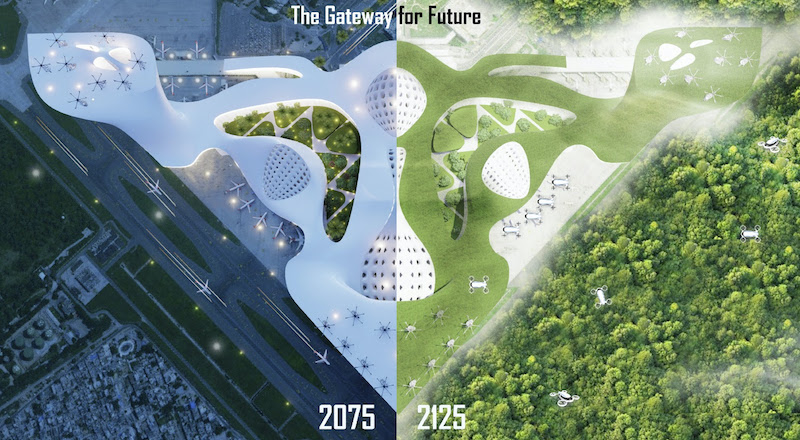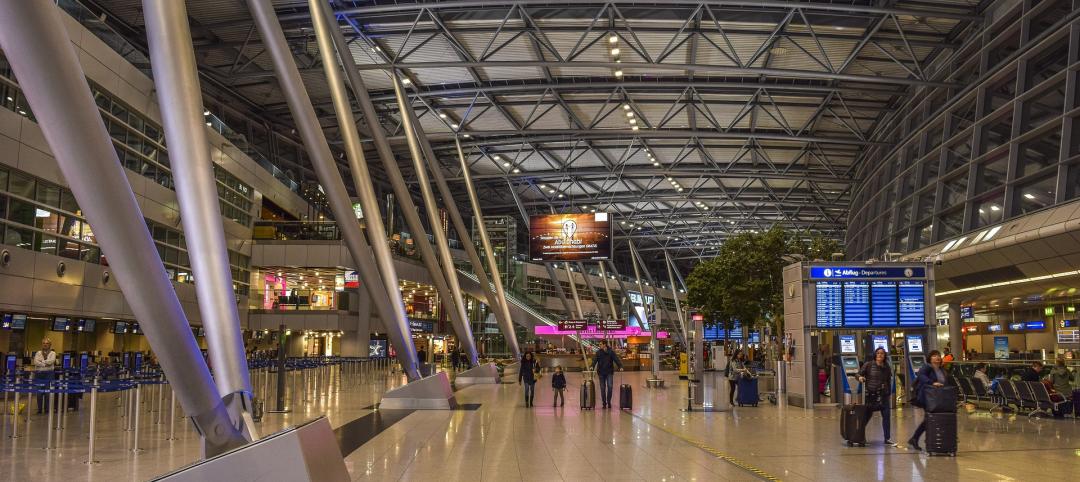The Green Gateway—a zero-emission, highly sustainable multimodal hub—has been named the winner for the 2020 Fentress Global Challenge (FGC), an annual global student design competition launched in 2011 by Fentress Architects that represents the firm’s commitment to advancing innovative design in public architecture and attracts students from around the world.
Envisioning the Airport of the Future
With over 100 submissions from students in over 15 countries, this year’s competition challenged participants to envision airport mobility in the year 2100. Participants proposed a diverse spectrum of design concepts to improve the airport passenger terminal building, addressing the key factors such as futuristic transportation technologies, urbanization, globalization, technology, flexibility, security, project feasibility, and passenger experience.
The 2020 winning proposals reflect the radical innovation, quality and curiosity required to advance airport terminal design. The first-place prize is valued at USD$15,000, second place USD$3,000, third place USD$2,000, and the two People’s Choice Awards will receive USD$1,000.
“A deep passion for design and a creative mindset are the cornerstone of any successful design competition submission,” said Curtis Fentress, FAIA, RIBA, Principal in Charge of Design at Fentress Architects. “Each year, the submissions we receive are more innovative, spirited and dynamic than the prior year, which shows an exciting outlook for the future of terminal design. We’re greatly impressed by this year’s winners and every submission we received.”
 First-Place Winner: BANIYA, The Green Gateway, designed by Nikhil Bang and Kaushal Tatiya from the Southern California Institute of Architecture.
First-Place Winner: BANIYA, The Green Gateway, designed by Nikhil Bang and Kaushal Tatiya from the Southern California Institute of Architecture.
A Green Gateway
The winning concept, designed by Nikhil Bang and Kaushal Tatiya from the Southern California Institute of Architecture (SCI-Arc), transforms Indira Gandhi International Airport into a forward-thinking, sustainable multimodal hub that mitigates the enivironmental impacts of air travel while enhancing mobility across New Delhi, India—one of the most populated and polluted cities in the world. The design, dubbed “the Green Gateway,” proposes a future where airports are more than buildings; they provide a seamless connection to the cultural context of the site, from their planning to their form and materiality.
Embracing sustainable design strategies, the zero-emission concept features a decentralized system of one central terminal and six towers dispersed throughout the city. The towers provide a dual purpose, working as both air-purifying centers and stations for flying cars. This solution significantly improves mobility across the city by replacing domestic flights as one of the major sources of pollution.
The students’ submission describes the airport’s design as “zero-emission at the macro and micro level, improving mobility across the city by replacing domestic flight as one of the major sources of pollution and making air travel a personal affair.”
Second Place Winner
Second-Place Winner: Sejkul, Hartsfield-Jackson Atlanta International Drive-In Airport by Dušan Sekulic, University of Ljubljana, Slovenia.
What does travel and transportation look like in 2100? According to second-place winner Dušan Sekulic—a student at the University of Ljubljana, Slovenia—fully autonomous pods, driving chairs, AI-powered navigation, and vertical take-off and landing (VTOL) aircraft will be key ingredients to designing the next-gen airport experience. The concept proposes reimagining Hartsfield-Jackson Atlanta International Airport (ATL)—the busiest airport in the world—as a drive-in airport where travelers’ individual pods and driving chairs bring them directly to the aircraft. Playing off of Atlanta’s reputation as a “city in the forest,” the new ATL will feature a green design approach, merging the airport with the city’s skyline to create an “airport in the forest.”

Autonomous pods move passengers throughout the futuristic terminal. Second-Place Winner: Sejkul, Hartsfield-Jackson Atlanta International Drive-In Airport by Dušan Sekulic, University of Ljubljana, Slovenia.
Third Place Winner

Third-Place Winner: W.A.D, Floating Aero City designed by Yuanxiang Chan, Chaofan Zhang, and Zhuangzhuang King from Beijing Jiaotong University.
This year’s third-place winner responded to an ever-important reality: how airport design can prepare airports located in high density seaside cities to adapt to the effects of climate change. Floating Aero City, designed by Yuanxiang Chan, Chaofan Zhang, and Zhuangzhuang King from Beijing Jiaotong University, provides a highly visionary approach to sustainable design. Located in Hong Kong, the airport responds to the site’s subtropical climate conditions and high density issues. Floating on Hong Kong’s ocean, the airport’s three-dimensional, moveable platform reduces the impact on the natural terrain while increasing available land. The structure’s vertical form significantly reduces the time it takes passengers to flow from check-in to boarding, enhancing the overall passenger experience. Sustainable design strategies include daylighting, tidal power generation, a circular runway and hydrogen-powered aircraft.
People’s Choice Awards

#1 People’s Choice Award Winner: Arch YiYang, The Vertebrae, designed by Yi Yang Chai and Sharon Cho from the University of Malaya.
The Vertebrae, designed by Yi Yang Chai and Sharon Cho from the University of Malaya, won the #1 People’s Choice Award with more than 6,200 public votes. The biophilic design harmonizes the built environment with nature to create a “garden city”—the future airport archetype that forms a contextual representation of its culture. Located in Singapore, the concept infuses a biophilic and sustainable approach into every element of the design to renvision the airport as a model of sustainability while amplifying the country’s national identity.
“This is a beautiful concept with a strong connection to existing structures and attention to the environment,” said Lois Kramer, a 2020 FGC Juror and CEO at KRAMER aerotek inc. “The design is resilient in how it addresses air pollution and possibility of evolving modes of transportation."

#2 People’s Choice Award Winner: RIE, O’Pon the Hill, designed by Ridwan Arifin, Imaduddin Dhia Ul-Fath and Ervin Dwiratno from Yogyakarta University of Technology
Garnering over 5,900 public votes, O’Pon the Hill Airport landed the #2 People’s Choice Award. Designed by Ridwan Arifin, Imaduddin Dhia Ul-Fath and Ervin Dwiratno from Yogyakarta University of Technology, the concept blends culture, history and technology to envision the future of O’Hare International Airport. This futuristic terminal features a Smart Air Pad to accommodate vertical take-off and landing. Equipped with nanotechnology, the Smart Air Pad examines the performance of aircraft. Additionally, People Mover Pods move passengers throughout the terminal, enhancing circulation and the overall passenger experience.
2020 Fentress Global Challenge Jurors
This year’s winners were handpicked by seven esteemed jurors that are experts in aviation, architecture and engineering.
Jury members include:
- Curtis W. Fentress, FAIA, RIBA – Principal in Charge of Design, Fentress Architects
- Agatha Kessler – Chairman, Fentress Architects
- Lois Kramer – CEO, KRAMER aerotek inc.
- George Miller – COO, Richard Meier & Partners Architects LLP
- Dr. Patricia A. Ryan – President, Decision Services International
- Somer Shindler – Owner, J. Shindler Solutions
- Bradley D. Schulz, FAIA
Looking Ahead
The future of aviation and airport terminal design is an everchanging vision. The Fentress Global Challenge provides an essential platform for students to test their innovation and fuel their creativity. With the new year quickly approaching, Fentress is excited to prepare for the 2021 Fentress Global Challenge. Registration will soon go live. To stay updated on next year’s competiton, please visit: https://
Related Stories
Airports | Apr 18, 2024
The next destination: Passive design airports
Today, we can design airports that are climate resilient, durable, long-lasting, and healthy for occupants—we can design airports using Passive House standards.
Airports | Feb 13, 2024
New airport terminal by KPF aims to slash curb-to-gate walking time for passengers
The new Terminal A at Zayed International Airport in the United Arab Emirates features an efficient X-shape design with an average curb-to-gate walking time of just 12 minutes. The airport terminal was designed by Kohn Pedersen Fox (KPF), with Arup and Naco as engineering leads.
Urban Planning | Feb 5, 2024
Lessons learned from 70 years of building cities
As Sasaki looks back on 70 years of practice, we’re also looking to the future of cities. While we can’t predict what will be, we do know the needs of cities are as diverse as their scale, climate, economy, governance, and culture.
Products and Materials | Jan 31, 2024
Top building products for January 2024
BD+C Editors break down January's top 15 building products, from SloanStone Quartz Molded Sinks to InvisiWrap SA housewrap.
Airports | Jan 30, 2024
Rafael Viñoly Architects’ design for the new Florence, Italy, airport terminal will feature a rooftop vineyard
At Florence, Italy’s Aeroporto Amerigo Vespucci, the new international airport terminal will feature a fully operating vineyard on the facility’s rooftop. Designed by Rafael Viñoly Architects, the terminal is expected to see over 5.9 million passengers annually. Renderings for the project have recently been released.
Airports | Jan 15, 2024
How to keep airports functional during construction
Gensler's aviation experts share new ideas about how to make the airport construction process better moving forward.
Airports | Dec 4, 2023
4 key innovations and construction trends across airport design
Here are some of the key trends Skanska is seeing in the aviation sector, from congestion solutions to sustainability.
Giants 400 | Nov 13, 2023
Top 60 Airport Facility Construction Firms for 2023
Hensel Phelps, Turner Construction, AECOM, and Walsh Group top BD+C's ranking of the nation's largest airport terminal and airport facilities general contractors and construction management (CM) firms for 2023, as reported in the 2023 Giants 400 Report.
Giants 400 | Nov 13, 2023
Top 65 Airport Facility Engineering Firms for 2023
AECOM, Jacobs, Arup, Burns & McDonnell, and WSP head BD+C's ranking of the nation's largest airport terminal and airport facilities engineering and engineering architecture (EA) firms for 2023, as reported in the 2023 Giants 400 Report.
Giants 400 | Nov 13, 2023
Top 65 Airport Facility Architecture Firms for 2023
Gensler, Corgan, PGAL, and HOK top BD+C's ranking of the nation's largest airport terminal and airport facilities architecture and architecture engineering (AE) firms for 2023, as reported in the 2023 Giants 400 Report.


















